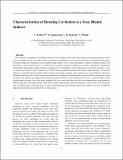| dc.contributor.author | Jackson, David | |
| dc.contributor.author | Lettieri, Claudio | |
| dc.contributor.author | Spakovszky, Zoltan S | |
| dc.contributor.author | Wang, Vincent | |
| dc.date.accessioned | 2016-12-08T19:01:41Z | |
| dc.date.available | 2016-12-08T19:01:41Z | |
| dc.date.issued | 2016-07 | |
| dc.identifier.isbn | 978-1-62410-406-0 | |
| dc.identifier.other | AIAA 2016-4986 | |
| dc.identifier.uri | http://hdl.handle.net/1721.1/105750 | |
| dc.description.abstract | This work aims to characterize the dynamic behavior of a four bladed inducer and clarify the physical mechanism that leads to the onset of rotating cavitation. The inducer under consideration is representative of a low-pressure liquid oxygen pump (LPOP) inducer of modern design and incorporates several standard design features used in rocket turbopumps to suppress rotating cavitation. The mechanism is characterized based on a combination of two-phase numerical simulations and inducer experiments. Experimental measurements demonstrate a supersynchronous rotating cavity in the periphery of the inducer inlet at frequencies between 1.2 and 1.6 times rotor frequency and a synchronous 2nd spatial harmonic pattern associated with alternate blade cavitation. The analysis indicates a causal link between alternate blade cavitation and rotating cavitation, with a distinct cut-on cut-off behavior. Numerical calculations and high-speed videos elucidate the mechanism of breakdown of alternate blade cavitation and the formation of rotating cavitation. The present work suggests that rotating cavitation is caused by the coupling of the cavities on adjacent blades during alternate blade cavitation. Due to the nearly tangential flow, the vortex lines from one of the non-cavitating blades wrap around the blade leading edge of the adjacent blade, which yields a drop in static pressure and cavity formation. The tip vortex cavity interaction with the leading edge of the blade leads to sheet cavity breakdown with periodic growth and collapse of cavities, creating the apparent super-synchronous rotation of the cavitating region. | en_US |
| dc.description.sponsorship | United States. National Aeronautics and Space Administration (NASA Marshall Space Flight Center) | en_US |
| dc.language.iso | en_US | |
| dc.publisher | American Institute of Aeronautics and Astronautics (AIAA) | en_US |
| dc.relation.isversionof | http://dx.doi.org/10.2514/6.2016-4986 | en_US |
| dc.rights | Creative Commons Attribution-Noncommercial-Share Alike | en_US |
| dc.rights.uri | http://creativecommons.org/licenses/by-nc-sa/4.0/ | en_US |
| dc.source | Prof. Spakovszky via Barbara Williams | en_US |
| dc.title | Characterization of Rotating Cavitation in a Four Bladed Inducer | en_US |
| dc.type | Article | en_US |
| dc.identifier.citation | Lettieri, Claudio, Zoltan Spakovszky, David Jackson, and Vincent Wang. “Characterization of Rotating Cavitation in a Four Bladed Inducer.” 52nd AIAA/SAE/ASEE Joint Propulsion Conference, July 25-27, 2016, Salt Lake City, UT. | en_US |
| dc.contributor.department | Massachusetts Institute of Technology. Department of Aeronautics and Astronautics | en_US |
| dc.contributor.approver | Spakovszky, Zoltan S | en_US |
| dc.contributor.mitauthor | Lettieri, Claudio | |
| dc.contributor.mitauthor | Spakovszky, Zoltan S | |
| dc.contributor.mitauthor | Wang, Vincent | |
| dc.relation.journal | 52nd AIAA/SAE/ASEE Joint Propulsion Conference, AIAA Propulsion and Energy Forum | en_US |
| dc.eprint.version | Author's final manuscript | en_US |
| dc.type.uri | http://purl.org/eprint/type/ConferencePaper | en_US |
| eprint.status | http://purl.org/eprint/status/NonPeerReviewed | en_US |
| dspace.orderedauthors | Lettieri, Claudio; Spakovszky, Zoltan; Jackson, David; Wang, Vincent | en_US |
| dspace.embargo.terms | N | en_US |
| dc.identifier.orcid | https://orcid.org/0000-0003-2167-9860 | |
| dc.identifier.orcid | https://orcid.org/0000-0002-9742-1965 | |
| mit.license | OPEN_ACCESS_POLICY | en_US |
